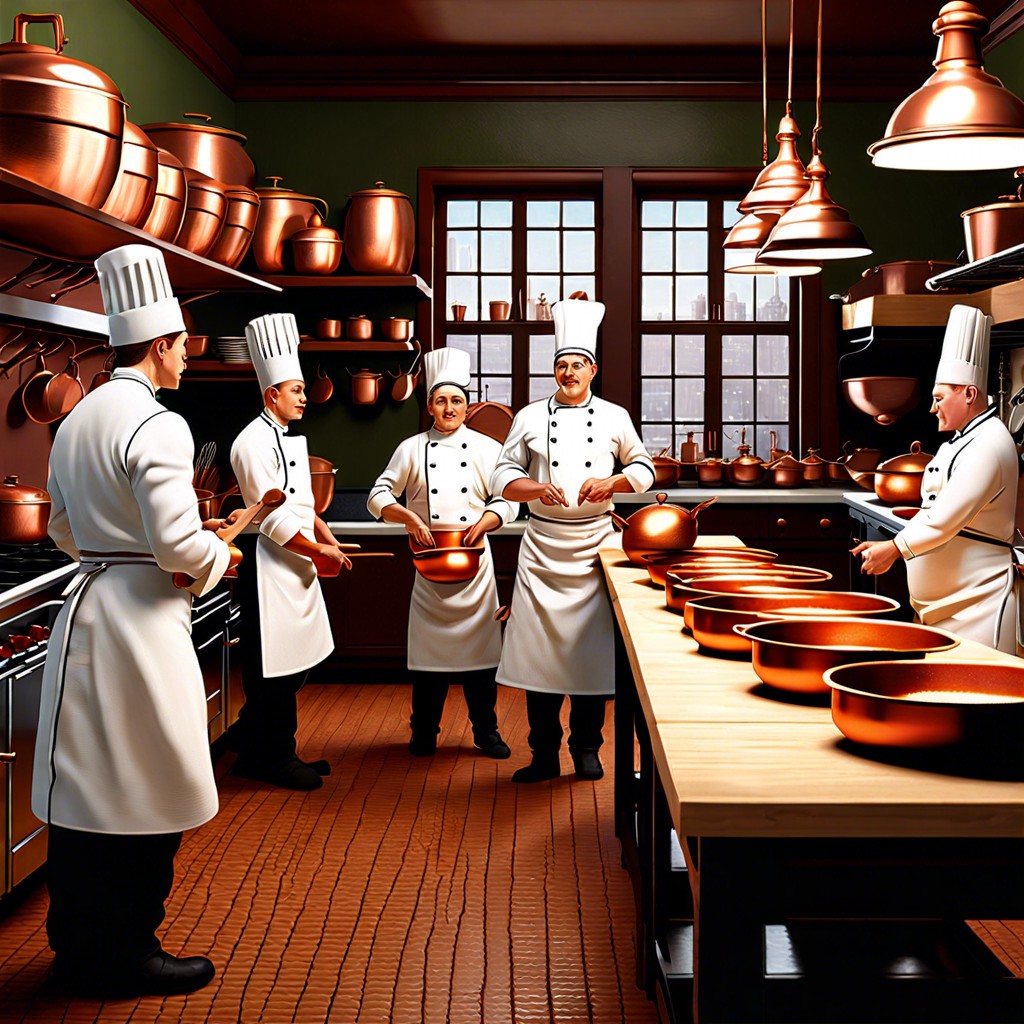Last updated on
Uncover the structured hierarchy and diverse roles within the dynamic kitchen brigade system, enhancing the efficiency and culinary excellence of professional kitchens.
Key takeaways:
- The kitchen brigade system was established by Escoffier for increased efficiency.
- The Executive Chef oversees overall kitchen operations and financial management.
- Sous Chef is crucial in menu planning, staff management, and food preparation.
- Benefits of a structured brigade include clarity, specialization, and scalability.
- Escoffier’s system emphasized efficiency, teamwork, and professional status.
What's Inside
History of the Kitchen Brigade System

The birth of the kitchen brigade is a nod to the military precision required for a kitchen to function smoothly. This hierarchical framework was standardized by Georges Auguste Escoffier, a French chef, restaurateur, and culinary writer in the late 19th and early 20th centuries. Escoffier’s intention was not just to bring order but also to increase efficiency in the kitchen.
His system drew inspiration from his military experience, embracing a strict chain of command and division of labor. This turned chaotic and unsystematic kitchen operations into well-organized units where each member had a specific role. By mirroring the regimented structure found in military units, Escoffier aimed to create a sense of unity and professionalism among kitchen staff that would be reflected in the quality of the food and service.
In essence, the kitchen brigade system revolutionized how kitchens operated, setting the standard for restaurant and hotel dining across the world. It not only smoothened workflow but also instilled a sense of dignity and respect within the culinary profession. Because of this vital reformation, many of the roles and terminologies established over a century ago are still in use today, underscoring the enduring legacy of Escoffier’s vision.
The Role of the Chef Exécutif (Executive Chef)
At the helm of the kitchen brigade stands the Executive Chef. Imagine a conductor in an orchestra, this individual synchronizes the kitchen’s overall operations, ensuring that culinary standards are top-notch and consistent. Their daily tasks are multifaceted, showcasing their versatility within the culinary realm.
Leadership and management are core to their role, encompassing menu creation, inventory control, and team supervision. In essence, they take the wheel when steering the kitchen’s creative direction. Their hands might rarely touch the pots and pans, but their fingerprints are on every dish that leaves the kitchen.
Not only do they focus on maintaining the culinary quality, but they also keep a keen eye on the kitchen’s financial health. Costing menus and managing budgets are as crucial to their role as curating a delectable plate of food. They must balance art and commerce, presenting plates that both ignite the senses and meet the profit margins.
Communication is another essential aspect, as they liaise with suppliers for the freshest produce, negotiate prices, and ensure the kitchen stays flush with top-tier ingredients. They might not be the ones chopping the onions, but their decisions influence every texture and taste presented to the diner.
While not visible to those enjoying their meals, the impact of the Executive Chef is omnipresent, guaranteeing that the dining experience is as flawless as the operational flow behind the scenes.
Responsibilities of the Sous Chef De Cuisine (Sous Chef)
The Sous Chef, often the second-in-command, operates as the dispatcher in the kitchen’s symphony. In the absence of the Executive Chef, they assume full command, which comes with a slew of critical duties. They are involved heavily in menu planning, often adding creative input and expertise. Additionally, they manage the kitchen staff, ensuring that each section operates efficiently and maintains high standards.
Training and supervising are also part of their remit. The Sous Chef leads by example, setting a professional tone within the kitchen. They are the disciplinarian, the mentor, and sometimes even mediator, ensuring smooth staff interactions. Inventory management falls under their umbrella as well, requiring them to order supplies, control quality, and manage costs.
Another layer of their role includes maintaining safety and hygiene standards. They conduct regular checks and enforce the regulations, crucial to a professional culinary environment. Finally, they play a significant role in the actual food preparation, often handling complex tasks and stepping in during peak times to keep the service running without a hitch.
In essence, the Sous Chef is the kitchen’s cornerstone, pivotal in every aspect of its operation.
Benefits of Having a Kitchen Brigade
The efficiency delivered by a well-structured kitchen brigade is unparalleled. Picture a symphony orchestra where each musician plays a distinct part; similarly, in a brigade, every chef has a clear role, contributing to the seamless execution of kitchen operations. This clarity reduces overlaps in responsibility, ensuring everyone knows their tasks inside and out.
Specialization is another hallmark. Chefs become masters in specific areas, be it sauces, pastries, or grilling. This not only cultivates expertise but also promotes a higher standard of dish consistency. Diners can anticipate the same high-quality experience with each visit, as the brigade’s compartmentalization ensures culinary excellence.
Communication also benefits immensely. A defined hierarchy simplifies the flow of instructions. Orders from the top trickle down with precision, leaving little room for error. The specificity of each role within the brigade fosters a sense of accountability among team members. When everyone understands the part they play in the larger puzzle, it creates a culture of mutual respect and shared purpose.
Scalability is an often-overlooked advantage. Whether serving a dinner for ten or a banquet for hundreds, the brigade system can adjust to the magnitude of work without sacrificing the quality of service. This ability to expand or contract effortlessly makes it suited for various culinary environments, from the smallest bistro to the grandest hotel kitchen.
Auguste Escoffier’s Influence On the Kitchen Brigade System
Auguste Escoffier revolutionized the culinary world with his structural reformation of kitchen staff organization. His approach brought military-like hierarchy and discipline to the chaos that often reigned in large, upscale kitchens. Escoffier’s system is known for simplifying and streamlining work by defining clear roles and responsibilities for all staff members, from the executive chef down to the line cooks.
This effective system emphasized efficiency, teamwork, and respect for the chain of command. For instance, Escoffier segregated tasks by creating specialized stations, such as the ‘garde manger’ for cold dishes and the ‘sauté chef’ for sautéed items and sauces. This compartmentalization allows for an environment where chefs can focus on mastering specific tasks, leading to a higher standard of food quality and preparation.
Furthermore, his influence extended beyond physical organization into the empowerment of the chef as a respected professional, elevating the position’s status within the gastronomic and hospitality industries.
Escoffier’s legacy in the kitchen brigade system is such that it remains the backbone of many modern professional kitchens, testament to its time-tested efficiency and effectiveness.





